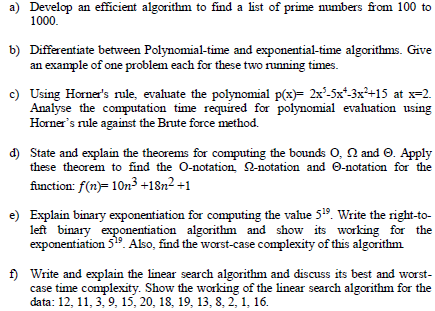a) Develop an efficient algorithm to find a list of prime numbers from 100 to 1000. b) Differentiate between Polynomial-time and exponential-time algorithms. Give an example of one... a) Develop an efficient algorithm to find a list of prime numbers from 100 to 1000. b) Differentiate between Polynomial-time and exponential-time algorithms. Give an example of one problem each for these two running times. c) Using Horner's rule, evaluate the polynomial p(x)= 2x^5-5x^3+15 at x=2. Analyse the computation time required for polynomial evaluation using Horner’s rule against the Brute force method. d) State and explain the theorems for computing the bounds O, Ω, and Θ. Apply these theorems to find the O-notation, Ω-notation, and Θ-notation for the function: f(n)= 10n^3 + 18n^2 + 1. e) Explain binary exponentiation for computing the value 5^19. Write the right-to-left binary exponentiation algorithm and show its working for the exponentiation 5^19. Also, find the worst-case complexity of this algorithm. f) Write and explain the linear search algorithm and discuss its best and worst-case time complexity. Show the working of the linear search algorithm for the data: 12, 11, 3, 9, 15, 20, 18, 19, 13, 8, 2, 1, 16.

Understand the Problem
The question consists of multiple parts focused on algorithms and computational complexity, including tasks like developing an algorithm for prime numbers, differentiating algorithm types, evaluating polynomials, explaining computational bounds and complexity theorems, and discussing binary exponentiation and linear search algorithms.
Answer
Use Sieve of Eratosthenes for primes 100-1000. Polynomial vs Exponential time: O(n^2) vs O(2^n). Horner's Rule evaluates p(2)=39 faster than brute force. f(n)=10n^3+18n^2+1 is Θ(n^3). Binary exponentiation for 5^19: O(log n). Linear search best O(1), worst O(n).
a) You can use the Sieve of Eratosthenes to efficiently find the prime numbers from 100 to 1000. b) Polynomial-time algorithms run in polynomial time, e.g., O(n^2), while exponential-time algorithms, e.g., O(2^n), grow exponentially. Example: Polynomial - Sorting, Exponential - Traveling Salesman Problem. c) Using Horner's Rule, evaluate p(2) = 39; it's more efficient than the brute force method. d) The function f(n) = 10n^3 + 18n^2 + 1 has O(n^3), Ω(n^3), and Θ(n^3) bounds. e) Binary exponentiation of 5^19 is efficient with complexity O(log n). f) Linear search has a best-case complexity of O(1) and worst-case of O(n); it sequentially checks each element.
Answer for screen readers
a) You can use the Sieve of Eratosthenes to efficiently find the prime numbers from 100 to 1000. b) Polynomial-time algorithms run in polynomial time, e.g., O(n^2), while exponential-time algorithms, e.g., O(2^n), grow exponentially. Example: Polynomial - Sorting, Exponential - Traveling Salesman Problem. c) Using Horner's Rule, evaluate p(2) = 39; it's more efficient than the brute force method. d) The function f(n) = 10n^3 + 18n^2 + 1 has O(n^3), Ω(n^3), and Θ(n^3) bounds. e) Binary exponentiation of 5^19 is efficient with complexity O(log n). f) Linear search has a best-case complexity of O(1) and worst-case of O(n); it sequentially checks each element.
More Information
The Sieve of Eratosthenes is a classic algorithm for finding all prime numbers up to a specified integer. Horner’s method optimizes polynomial evaluation by reducing the number of multiplications needed.
Tips
Confusing O, Ω, and Θ definitions in complexity analysis can lead to errors. Practice writing algorithms for binary exponentiation to understand efficiency.
Sources
- Binary Exponentiation - GeeksforGeeks - geeksforgeeks.org
- Sieve of Eratosthenes - Wikipedia - en.wikipedia.org
- Asymptotic Bounds - Big O, Ω, and Θ - javatpoint.com
AI-generated content may contain errors. Please verify critical information